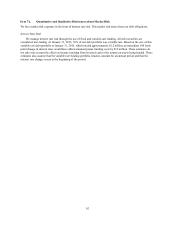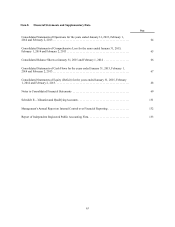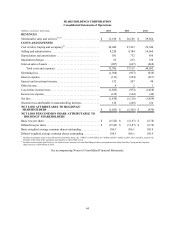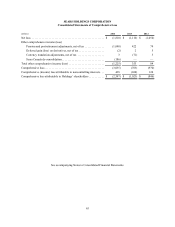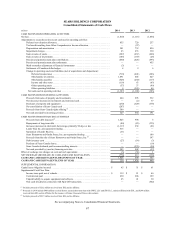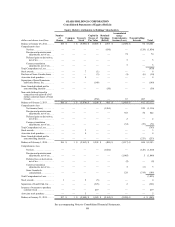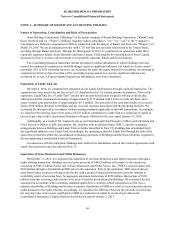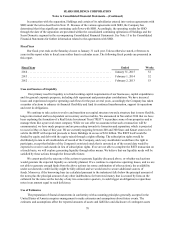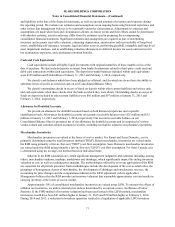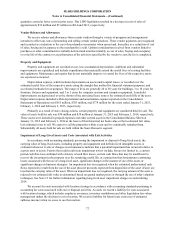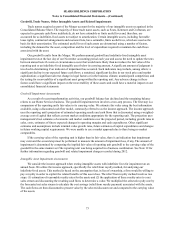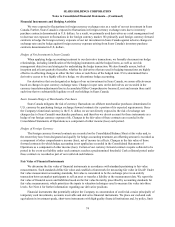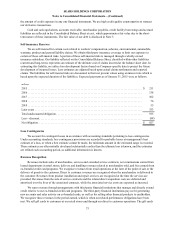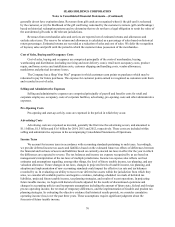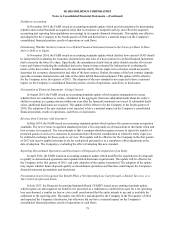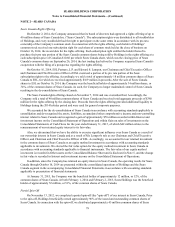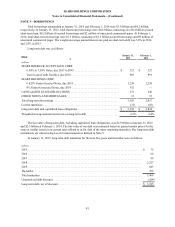Sears 2014 Annual Report Download - page 72
Download and view the complete annual report
Please find page 72 of the 2014 Sears annual report below. You can navigate through the pages in the report by either clicking on the pages listed below, or by using the keyword search tool below to find specific information within the annual report.SEARS HOLDINGS CORPORATION
Notes to Consolidated Financial Statements—(Continued)
72
quantities carried at lower costs in prior years. This LIFO liquidation resulted in a decrease in cost of sales of
approximately $32 million and $7 million in 2014 and 2013, respectively.
Vendor Rebates and Allowances
We receive rebates and allowances from certain vendors through a variety of programs and arrangements
intended to offset our costs of promoting and selling certain vendor products. These vendor payments are recognized
and recorded as a reduction to the cost of merchandise inventories when earned and, thereafter, as a reduction of cost
of sales, buying and occupancy as the merchandise is sold. Upfront consideration received from vendors linked to
purchases or other commitments is initially deferred and amortized ratably to cost of sales, buying and occupancy
over the life of the contract or as performance of the activities specified by the vendor to earn the fee is completed.
Property and Equipment
Property and equipment are recorded at cost, less accumulated depreciation. Additions and substantial
improvements are capitalized and include expenditures that materially extend the useful lives of existing facilities
and equipment. Maintenance and repairs that do not materially improve or extend the lives of the respective assets
are expensed as incurred.
Depreciation expense, which includes depreciation on assets under capital leases, is recorded over the
estimated useful lives of the respective assets using the straight-line method for financial statement purposes, and
accelerated methods for tax purposes. The range of lives are generally 20 to 50 years for buildings, 3 to 10 years for
furniture, fixtures and equipment, and 3 to 5 years for computer systems and computer equipment. Leasehold
improvements are depreciated over the shorter of the associated lease term or the estimated useful life of the asset.
Depreciation expense included within depreciation and amortization expense reported on the Consolidated
Statements of Operations was $563 million, $703 million, and $778 million for the years ended January 31, 2015,
February 1, 2014 and February 2, 2013, respectively.
Primarily as a result of store closing actions, certain property and equipment are considered held for sale. The
value of assets held for sale was $30 million and $39 million at January 31, 2015 and February 1, 2014, respectively.
These assets were included in prepaid expenses and other current assets in the Consolidated Balance Sheets at
January 31, 2015 and February 1, 2014 at the lower of their historical net book value or their estimated fair value,
less estimated costs to sell. We expect to sell the properties within a year and we continually remarket them.
Substantially all assets held for sale are held within the Sears Domestic segment.
Impairment of Long-Lived Assets and Costs Associated with Exit Activities
In accordance with accounting standards governing the impairment or disposal of long-lived assets, the
carrying value of long-lived assets, including property and equipment and definite-lived intangible assets, is
evaluated whenever events or changes in circumstances indicate that a potential impairment has occurred relative to
a given asset or assets. Factors that could result in an impairment review include, but are not limited to, a current
period cash flow loss combined with a history of cash flow losses, current cash flows that may be insufficient to
recover the investment in the property over the remaining useful life, or a projection that demonstrates continuing
losses associated with the use of a long-lived asset, significant changes in the manner of use of the assets or
significant changes in business strategies. An impairment loss is recognized when the estimated undiscounted cash
flows expected to result from the use of the asset plus net proceeds expected from disposition of the asset (if any) are
less than the carrying value of the asset. When an impairment loss is recognized, the carrying amount of the asset is
reduced to its estimated fair value as determined based on quoted market prices or through the use of other valuation
techniques. See Note 13 for further information regarding long-lived asset impairment charges recorded during
2014.
We account for costs associated with location closings in accordance with accounting standards pertaining to
accounting for costs associated with exit or disposal activities. As such, we record a liability for costs associated
with location closings, which includes employee severance, inventory markdowns and other liquidation fees when
management makes the decision to exit a location. We record a liability for future lease costs (net of estimated
sublease income) when we cease to use the location.


